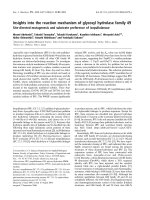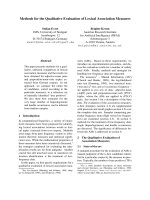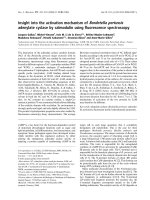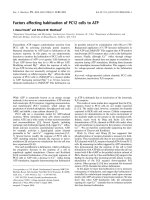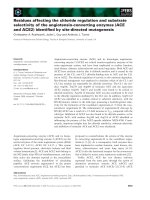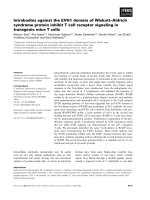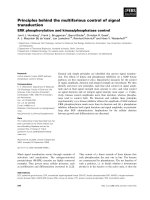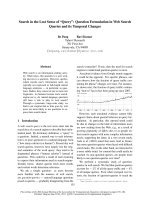Báo cáo khoa học: "Factors affecting the interfacial properties of surfactant absorbed layers on an oil droplet surface" pptx
Bạn đang xem bản rút gọn của tài liệu. Xem và tải ngay bản đầy đủ của tài liệu tại đây (336.95 KB, 9 trang )
Journal of Science and Development April 2008: 8-16 HANOI UNIVERSITY OF AGRICULTURE
Factors affecting the interfacial properties of surfactant absorbed
layers on an oil droplet surface
Nguyen Duc Doan
*
, Paul Vander Meeren
**
* Faculty of Food Science and Technology, Hanoi University of Agriculture,
Trau quy, Gia lam, Ha Noi, Viet Nam
** Faculty of Bioengineering, Ghent University, Coupure liks 653, 9000 Gent, Belgium
Abstract
Proteins and low molecular weight (LMW) surfactants are widely used for the physical
stabilization of many emulsions and foam - based food products. The formulation and
stabilization of emulsions and foams depend strongly on the interfacial properties of the
proteins and LMW surfactants. The effect of proteins and LMW surfactants, sodium caseinate
concentration and calcium concentration on the interfacial tension and interfacial dilational
modulus on the n-hexadecane/water interface was determined by an automatic drop
tensiometer. The experimental data represented the interfacial tension and modulus as a
function of the adsorption time, protein concentration in the bulk phase and calcium chloride
concentration.
Keywords: interfacial tension, interfacial dilational modulus, sodium caseinate, whey protein
isolate.
1. INTRODUCTION
Protein and low molecular weight (LMW)
surfactants play a crucial role in the stabilization
of emulsions and foams. Emulsion and foam
stability strongly depends on the behaviour of
these interfaces (Bos & van Vliet, 2001). The
interfacial tension provides an indication of the
film compactness: the lower the interfacial
tension, the more compact the film becomes. The
interfacial rheology can be described as the
resistance of the interface to deformation and
film strength (Burgess & Ozlen Sahin, 1997).
Knowledge of the interfacial properties of
adsorbed films is necessary to understand the
role of protein and LMW surfactants in emulsion
and foam stability.
Burgess and Ozlen Sahin (1997)
investigated the effect of bulk concentration,
temperature, pH and ionic strength on the
interfacial properties by a Mark II surface
rheometer. In the present study, the influence
of different surfactants, protein concentrations
and calcium chloride concentration on the
interfacial tension and interfacial rheology was
envestigated.
The aim of this research was to find a
surfactant, a protein concentration and a calcium
concentration on the absorbed layers on an oil
droplet surface, which have a low interfacial
tension and a high interfacial modulus.
2. MATERIALS AND METHODS
2.1. Materials
Sodium caseinate was supplied by Armor
Proteins, France. This product contained
94.13% dry matter of which 94.77% was
protein, 9750 ppm Na and 486 ppm Ca. Whey
protein isolate (WPI) was supplied by Davisco
International (USA). It contained 94.98% dry
matter of which 97.53% is protein, 3950 ppm
Na and 823 ppm Ca. The molecular weight of
WPI was assumed to be the same as that of β-
lactoglobulin (18363 g/mol). Tween 20 was
8
Factors affecting the interfacial properties of surfactant absorbed layers
supplied from Sigma-Aldrich Chemie GmbH,
Germany. It is a member of the polysorbate
group and is a non-ionic surfactant.
Calcium chloride was obtained from
MERCK, Germany.
Sunflower oil was purchased at the local
supermarket in Gent, Belgium.
The n-hexadecane with purity of 99% was
supplied by Sigma chemical Company.
For purified sunflower oil, the purification
was carried out as follows:
10 g of silica gel was mixed with 250 ml
sunflower oil into a 500 ml beaker. This
mixture was stirred for 4 hours. At the end, it
was centrifuged at 3000 rpm for 20 min. The
purified oil was carefully withdrawn with a
syringe or pipette.
2.2. Methods
2.2.1 Preparation of dispersions
Dispersion of sodium caseinate: 100mg
sodium caseinate in 100 ml acetate buffer
solution at pH 6.0 made from pure water was
dispersed by magnetic stirring for 1 hour. The
dispersed sodium caseinate was filtered through
Whatman N
0
1 filter paper to get the sodium
caseinate dispersion of 1 mg/ml. Sodium
caseinate dispersions with a concentration of
0.1 and 0.01 mg/ml were obtained by diluting
the above mentioned sodium caseinate
dispersion (1 mg/ml) in acetate buffer solution
pH 6. 0 by a factor of 10 and 100, respectively.
Dispersion of WPI: 10 g whey protein
isolate in 100 ml acetate buffer solution at pH
6.0 made from pure water was dispersed by
magnetic stirring for 1 hour to make a
concentration of those of 0.1 mg/ml.
Solution of Tween 20: 10 g Tween-20 in
100 ml acetate buffer solution at pH 6.0 made
from pure water was dispersed by magnetic
stirring for 1 hour to make a concentration of
those of 0.1 mg/ml.
Sodium caseinate dispersions of 0.01
mg/ml containing 1, 10 and 20 mM CaCl
2
was
prepared by diluting 2 ml of sodium caseinate
dispersion of 1 mg/ml to 100ml by acetate
buffer pH 6.0. This dispersion was mixed with
2, 20, and 40 mM CaCl
2
-containing buffer
solution at pH 6.0 at a ratio of 1:1.
2.2.2. Measurement of interfacial properties
The interfacial tension and interfacial
modulus at the oil/water interface were
measured by using the automatic drop
tensiometer (Tracker, IT-Concept, Saint-
Clementes Places, France). The experiments on
the interfacial tension were carried out by
adding 30 ml of water phase into the glass
cuvette. The other parameters of the assays
were fixed as follows: drop density (kg/dm
3
) of
0.7733, bulk density (kg/dm
3
) of 1.0000, rising
drop, initial volume of 10 µl after expelling 1
drop, measurement time of 1800 or 3600
seconds, non measurement of sinusoidal profile.
The experiments on the interfacial modulus
were carried out for 5 minutes after the
interfacial tension was measured until the
equilibrium stage. The main parameters were
set to measure a volume sinusoidal profile as
follows: amplitude of 1.5 µl, period of 10
seconds.
Statistical analysis: Data generated from
different determinations were analyzed using
the SPSS program.
3. RESULTS AND DISCUSSION
3.1. Effect of type of oil on the interfacial
tension and modulus of the adsorbed film at
the oil/water interface
In many food formulations the proteins are
not the only emulsifiers present, because small
molecular surfactants are also present in the
food formulation. Commercial sunflower oil
usually used in food emulsion production not
only contain triacylglycerol, but also contains
mono-, diacylglycerol and fatty acids. The latter
can compete with proteins to adsorb into the
fluid/fluid interface when making emulsions.
9
Nguyen Duc Doan, Paul Vander Meeren
Table 1. The interfacial modulus at the oil/pure water interface after 30 min (n=2)
Type of oil
Modulus
(mN/m)
Elasticity
(mN/m)
Viscosity
(mN/m)
Non purified sunflower oil 5.22 4.66 1.52
Purified sunflower oil 6.92 6.82 0.92
The interfacial tension and modulus are
two important parameters to determine the
purity of the oil. The effect of the type of oil on
the interfacial tension and modulus is shown in
Figure 1 and Table 1. Figure 1 shows that the
interfacial tension in the sunflower oil/pure
water interface and in the purified oil/pure
water interface decreased very rapidly to an
equilibrium value of 25 mN/m. On the other
hand, the interfacial dilational modulus is 5.22
and 6.92 mN/m for non purified oil and purified
oil, respectively.
The interfacial tension and modulus of the
purified oil/pure water interface were expected
to be 28 mN/m and near 0 mN/m, respectively
(Van der Meeren, 2005). Hence, both sunflower
oil and purified oil likely contain mono-,
diacylglycerol and fatty acids.
0
5
10
15
20
25
30
0 500 1000 1500 2000
Time (s)
Interfacial tension (mN/m)
purified sunflower oil
sunflower oil
Figure 1. The interfacial tension at the oil/pure water interface
The interfacial tension and modulus of the
oil/water interface was studied with a 0.1 mg/ml
protein solution. Depending on the type of oil
used, the interfacial tension varied between 8 and
22 mN/m (Bos & van Vliet, 2001). Figure 2
shows that decreasing the interfacial tension with
time is significantly different between the three
types of oil. For hexadecane, the interfacial
tension decreased very rapidly from 48 to 17
mN/m, and remained constant during measuring.
For sunflower oil and purified oil, the dynamic
interfacial tensions were virtually the same and
decreased very quickly from 26 to a plateau
value of 12 mN/m.
Table 2. Interfacial dilational modulus of 0.1 mg/ml sodium caseinate in acetate buffer at pH 6.0
against the types of oil (n = 3)
Type of oil Modulus (mN/m) Elasticity (mN/m) Viscosity (mN/m)
Non purified sunflower oil 6.67 ± 0.06
a
6.63 ± 0.01
a
1.27 ± 0.40
a
Purified sunflower oil 7.91 ± 0.28
ab
7.84 ± 0.28
ab
1.03 ± 0.09
a
n-Hexadecane 11.31 ± 1.55
b
10.51 ± 1.45
b
4.17 ± 0.53
b
(Different superscript letters indicate a significant difference at 95% among the values of the various oils)
10
Factors affecting the interfacial properties of surfactant absorbed layers
While the dynamic interfacial tension of the
sunflower oil/water interface and of the purified
oil/water interface decreased more rapidly as
compared to that of the n-hexadecane/water
interface, the interfacial dilational modulus was
lower after 30 min (Table 2). To eliminate the
influence of mono-, diacylglycerol and fatty
acids being present in vegetable oil for
experimental data on the effect of calcium
chloride on the interfacial tension and modulus
at the oil/water interface, n-hexadecane was
used as an oil phase for further experiments.
0
10
20
30
40
50
60
0 500 1000 1500 2000
Time (s)
Interfacial tension (
m
N
/
m
)
sunflower oil
purified oil
hexadecane
Figure 2. Effect of type of oil on interfacial tension on the oil/water interface (0.1 mg/ml sodium
caseinate in acetate buffer solution at pH 6.0)
3.2. Effect of various surface-active
compounds on interfacial properties on the
n-hexadecane/water intesrface
Sodium caseinate (α, β and κ) comprises a
family of proteins that lack a significant amount
of ordered structure, in contrast to globular
proteins such as WPI which often exhibits regular
secondary structures (Beverung et al., 1999).
Tween-20, a water-soluble low molecular weight
surfactant, is more surface-active than protein
(Wilde et al., 2004).
The effect of different surfactants, consisting
of sodium caseinate (NaCas), whey protein isolate
(WPI) and Tween 20, on the interfacial tension
and interfacial rheology was studied using a
dynamic drop tensiometer. The interfacial
rheology results of 0.1 mg/ml surfactant after
aging for 30 min at pH 6.0 are shown in Table 3.
The difference in interfacial rheology is very
significant (P = 0.00 << 0.05). The interfacial
dilational modulus of WPI was the highest (50.88
± 2.17 mN/m) followed by Tween 20 (20.32 ±
1.92 mN/m), sodium caseinate (11.31 ± 1.55
mN/m) and pure water (5.28 ± 0.01 mN/m). From
a rheological point of view, the interfacial
modulus on the oil/pure water interface is nearly
zero. In fact, it was observed that the interfacial
modulus was 5.28 mN/m.
The interfacial tension decreased with time,
reaching an equilibrium after about 10, 2 and 5
min for WPI, NaCas and Tween 20,
respectively (Figure 3). The interfacial tensions
of 0.1 mg/ml WPI, NaCas and Tween 20 and
hexadecane decreased from 41 mN/m to 20
mN/m, from 48 mN/m to 17.5 mN/m and from
31 mN/m to 8 mN/m, respectively.
11
Nguyen Duc Doan, Paul Vander Meeren
Table 3. Effect of various surfactants dissolved in acetate buffer (pH 6.0) on the interfacial dilational
modulus at the n-hexadecane/water interface after 30 min (n =3)
Surfactants
(0.1 mg/ml)
Modulus
(mN/m)
Elasticity
(mN/m)
Viscosity
(mN/m)
Pure water 5.28 ± 0.01
a
4.23 ± 0.95
a
2.43 ± 1.30
a
NaCas
11.31 ± 1.55
a
10.51 ± 1.45
a
4.17 ± 0.53
a
WPI
50.88 ± 2.17
b
50.11 ± 2.39
b
8.75 ± 1.06
b
Tween-20
20.32 ± 1.92
c
18.86 ± 1.81
c
7.57 ± 0.64
c
(Different superscript letters indicate a significant difference at 95% among the estimated moduli of the various
surfactants)
The rate of decrease in interfacial tension
(or increase of surface pressure, π = γ
0
- γ )
and interfacial modulus is determined by three
processes: (i) the diffusion of surfactant
molecules to attach to the interface; (ii)
spreading or unfolding of already adsorbed
molecules; and (iii) molecular rearrangements
of adsorbed molecules (Rodríguez Patino et
al., 2001).
The kinetics of LMW adsorption is
essentially determined by diffusion. The change
in the surface pressure with time is expressed
by Equation (1) (Rodríguez Patino et al., 2001).
However, several authors (MacRitchie, 1978)
have used this equation to describe the
adsorption of protein molecules from the bulk
to the interface.
π = 2.C.k.T.(D.t/3.14)
1/2
(1)
Where: C is the concentration in the bulk
phase
k is the Boltzman constant
T is the absolute temperature
D is the diffusion coefficient.
The time-dependent adsorption on the n-
hexadecane/water interface is seen in Figure 3.
It shows that Tween-20 reduced the interfacial
tension more effectively than sodium caseinate,
followed by WPI. The interfacial tension at the
n-hexadecane/pure water interface was nearly
50 mN/m.
The difference in adsorption of sodium
caseinate and that of WPI can be explained by
the disordered structure of sodium caseinate in
the bulk aqueous phase. It appears that the lack
of regular structure promotes rapid adsorption
and tension equilibration. The flexibility of
casein allows it to seek an equilibrium
conformation sooner than an ordered globular
protein, such as WPI. This may be due to the
strong adsorption of the hydrophobic C-
terminus, leaving the negatively charged amino
acid hydrophilic N-terminus suspended as loops
and tails in the aqueous phase. Meanwhile, WPI
with its ordered structure needs time for
unfolding and rearrangement as it is adsorbed
into the interface (Beverung et al., 1999).
The difference in interfacial dilational
modulus among the three surfactants is shown
in Table 3. Theoretically, Tween 20 was
expected to form the least viscoelastic adsorbed
layer, followed by sodium caseinate and WPI.
In fact the adsorbed layer by Tween 20 had a
higher modulus than that of sodium caseinate.
Girardet et al., (2001) investigated the
interfacial tension and interfacial rheology of
Tween 20 on the triolein/water interface with
the dynamic drop tensiometer (IT concept,
Longessaigne, France). These authors found
that the critical micellar concentration (CMC)
was 3.74 x 10
-6
M and the interfacial dilational
modulus obtained was 25 mN/m and 18 mN/m
at the CMC and 8.14 x 10
-5
M (0.1 mg/ml),
respectively.
12
Factors affecting the interfacial properties of surfactant absorbed layers
0
10
20
30
40
50
60
0 500 1000 1500 2000
Time (s)
Interfacial tension (mN/m)
Tween 20
WPI
sodium caeinat e
buffer solution
Figure 3. Effect of surfactants on the interfacial tension on the n-hexadecane/water interface
3.3. Effect of bulk concentration of sodium
caseinate on interfacial properties on the n-
hexadecane/water interface
The experimental transient surface
dynamic properties such as interfacial tension
and interfacial dilational modulus for sodium
caseinate adsorbed on the n-hexadecane/water
interface at pH 6 for 60 min, and at several
protein concentrations in the bulk water phase
are shown in Table 4 and Figure 4.
Table 4. Effect of the bulk concentration of sodium caseinate in acetate buffer (pH 6.0) on the
interfacial dilational modulus at n- hexadecane/water interface after 60 min (n=3)
Sodium caseinate concentration
(mg/ml)
Modulus
(mN/m)
Elasticity
(mN/m)
Viscosity
(mN/m)
0.01
12.16 ± 0.83
a
11.91± 0.84
a
2.34 ± 0.58
a
0.1
10.45 ± 1.12
a
9.91± 0.97
a
3.26 ± 0.92
a
1
6.69 ± 0.58
b
6.27 ± 0.55
b
2.29 ± 0.42
a
(Different superscript letters indicate a significant difference at 95% between the values at the various concentrations of
sodium caseinate)
The transient surface dynamic properties of
the adsorbed sodium caseinate film depend on
the protein concentration in the bulk phase. As
a general rule, it is expected that the interfacial
tension decreases and the interfacial dilational
modulus increases when the sodium caseinate
concentration in the bulk phase is increased. As
expected, the interfacial tension decreased with
time (Figure 4), but the interfacial dilational
modulus decreased as the protein concentration
in the bulk phase was increased (Table 4).
The interfacial tension decreased from 23
mN/m to 17 mN/m, from 48 mN/m to 17.5
mN/m and from 50 mN/m to 18.5 mN/m for 1,
0.1 and 0.01 mg/ml of protein, respectively.
The interfacial tension decreased with time,
reaching equilibrium within the first minutes at
0.1 and 1 mg/ml, and by 15 min at 0.01 mg/ml.
From these results we can deduce that the
concentration of protein in the bulk phase does
not affect the equilibrium interfacial tension
value to a large extent, but only affects the
dynamics of interfacial tension decrease if the
oil drop is aged for a long time. At low protein
concentrations, corresponding to 0.01 mg/ml,
the dynamic interfacial tension can be divided
into three time regimes: the first regime is an
induction regime, where the interfacial tension
remains relatively constant at the pure fluid
value. The second regime is characterized by a
sharp decline from this initial value. The final
regime is a steady decline in interfacial tension,
reaching a plateau value after several hours
(Beverung et al., 1999).
13
Nguyen Duc Doan, Paul Vander Meeren
The reduction in interfacial tension is a
result of protein adsorption and the ability of
adsorbed protein to interact with both phases.
Obviously, at high protein concentration in the
bulk phase, the protein molecules are rapidly
adsorbed into the interface to obtain a steady
plateau value. At low sodium caseinate
concentration in the bulk phase, the adsorption
of protein molecules was slower. Thus, the
interfacial tension did not significantly change
during the first minute and was nearly equal to
that of the n-hexadecane/pure water interface.
During this period, a relatively small amount of
protein molecules (insufficient to reach
monolayer coverage of the oil drop) is
adsorbed. After this time, more protein
molecules are adsorbed into the interface and
hence the interface becomes more saturated
with protein during aging. Thus, the interfacial
tension is reduced until a plateau value is
obtained.
The effect of protein concentration on the
bulk phase on the interfacial dilational modulus
is shown in Table 4. When increasing the
protein concentration from 0.01 mg/ml to 1
mg/ml, the modulus at 60 min decreased from
12.16 ± 0.83 mN/m to 6.69 ± 0.58 mN/m,
respectively. The difference in the interfacial
dilational modulus is very significant among
the protein concentrations in the bulk phase (P
= 0.001 << 0.05). This phenomenon can be
explained by the collapse of the charged
hydrophilic amino terminal tail of casein,
especially β-casein, into the aqueous phase
followed by readsorption onto the interface as
the drop was alternately compressed or dilated
(Girardet et al., 2001). These results are in
agreement with Girardet et al. (2001): when the
concentration of β-casein was increased from 1
mg/l to 15 mg/l, they observed that the modulus
decreased from 20 mN/m to 8 mN/m,
respectively.
0
10
20
30
40
50
60
0 1000 2000 3000 4000
Time (s)
Interfacial tension (mN/m)
0.01 mg/ml
0.1 mg/ml
1 mg/ml
pure water
Figure 4. Effect of bulk concentration of sodium caseinate in acetate buffer (pH 6.0) on the interfacial
tension on the n-hexadecane/water interface
3.4. Effect of calcium chloride concentration
on interfacial properties on the n-
hexadecane/water interface
An increase in ionic calcium concentration
did not result in a variation of the interfacial
tension as compared with a calcium-free protein
solution (Figure 5), but caused a reduction in the
interfacial dilational modulus (Table 5). The
interfacial dilational modulus at different CaCl
2
concentrations has a slightly significant
difference (P = 0.038 < 0.05). When adding 1, 10
and 20 mM CaCl
2
to 0.01 mg/ml sodium
caseinate in acetate buffer, the modulus
decreased from 13.51± 0.44 mN/m to 10.39 ±
2.21 mN/m and 9.62 ± 1.49 mN/m after 60 min,
respectively (Table 5).
14
Factors affecting the interfacial properties of surfactant absorbed layers
Table 5. Effect of the calcium chloride concentration on the interfacial dilational modulus at the n-
hexadecane/water interface at 60 min (sodium caseinate concentration of 0.01 mg/ml in acetate buffer
at pH 6.0) (n=3).
Concentration of CaCl
2
(mM)
Modulus (mN/m) Elasticity (mN/m)
Viscosity
(mN/m)
0
12.16 ± 0.83
ab
11.91± 0.84
ab
2.34 ± 0.58
a
1 13.51± 0.44
a
13.26 ± 0.37
a
2.61± 0.46
a
10 10.39 ± 2.21
ab
10.11± 2.14
ab
2.35 ± 0.64
a
20 9.62 ± 1.49
b
9.36 ± 1.53
b
2.08 ± 0.66
a
(Different superscript letters indicate a significant difference of 95% among the values at the various concentrations of
calcium chloride added to 0.01 mg/ml sodium caseinate)
In general, an increase in calcium ions
reduces the effective charge on the protein
molecules as a consequence of counter-ion
screening. The electrostatic repulsion
between neighboring molecules is reduced
and consequently adsorption and lateral
interaction increase, which results in the
reduction of interfacial tension and the
increase in the interfacial dilational modulus.
In fact the reverse was observed in these
experiments. This phenomenon can be
explained from the fact that the calcium
chloride concentration (1 mM) added to the
protein solution was not high enough to
change the adsorption of protein molecules
onto the interface. However, when calcium
chloride significantly exceeds the critical
concentration (10 mM), it results in the
formation of aggregates. This aggregation
would decrease the number of casein
molecules available for adsorption. On the
other hand, the binding of Ca
2+
to casein
partly collapses the adsorbed layer of casein
around the oil drops, although the casein still
provides a thick layer on the interface
(Dalgleish, 1997).
0
10
20
30
40
50
60
0 1000 2000 3000 4000
Time (s)
Interfacial tension (mN/m
)
+ 0 mM CaCl2
+ 1 mM CaCl2
+10 mM CaCl2
+20 mM CaCl2
Figure 5. Effect of concentration of calcium chloride on the interfacial tension of 0.01 mg/ml sodium
caseinate in acetate buffer (pH 6.0) on the n-hexadecane/water interface
15
Nguyen Duc Doan, Paul Vander Meeren
4. CONCLUSION
The change in the interfacial tension and
modulus were related to interfacial adsorption,
interaction and configurational changes. The
interfacial tension and modulus investigated
were dependent on time, surfactant,
concentration of protein and calcium ions.
These experiments on interfacial properties
have demonstrated that the interfacial tension of
Tween 20 decreased with time more rapidly
than sodium caseinate, followed by whey
protein isolate, whereas the interfacial modulus
was higher for whey protein isolate than that of
Tween 20 and sodium caseinate.
Although the interfacial tension decreased
more quickly with time for higher protein
concentrations in the bulk phase, almost the
same plateau values were obtained when aging
for a long time (hours). In contrast, the
interfacial modulus was higher for low protein
concentrations, corresponding to 0.01 mg/ml, as
compared to higher protein concentrations in
the bulk phase.
The decrease in interfacial tension with time
was not significantly affected by calcium, but the
interfacial modulus decreased as the amount of
CaCl
2
added to the protein solution was
increased. As the coalescence stability of
emulsions is known to be determined by the
resistance of the interfacial film, it is affected by
the presence of calcium ions: the stronger the
interfacial film, the more stable the resultant
emulsion. In practice, calcium ions may not
always be avoided. Since calcium is important
nutritionally, it has to be present in many food
formulations. It is of course important to study
an acceptable practical level of calcium that
ensures emulsion stability during processing and
storage.
REFERENCES
Beverung, C.J., Radke, C.J. and Blanch, H.W.
(1999). Protein adsorption at the
oil/water interface: characterization of
adsorption kinetics by dynamic
interfacial tension measurements.
Biophysical Chemistry 81: 59-80.
Bos, M. A. and Van Vliet, T. (2001). Interfacial
rheology properties of adsorbed protein
layers and surfactants: A Review.
Advances in Colloid and Interface
Science 91: 437-471.
Burgess, D. J. and Ozlen Sahin, N. (1997).
Interfacial rheological and tension
properties of protein films. Journal of
Colloid and Interface Science 189: 74-82.
Dalgleish, D.G. (1997). Adsorption of protein
and the stability of emulsions. Trends in
Food Science and Technology 8 (1): 1-6.
Girardet, J.M., Humbert, G., Creusot, N.,
Chardot, V., Campagna, S., Courthaudon,
J.L. and Gaillard, J.L. (2001). Dilational
rheology of mixed β-casein/Tween 20
and β-casein (f114-169)/Tween 20 films
at oil-water interface. Journal of Colloid
and Interface Science 243: 515-522.
MacRitchie, F. (1978). Protein at interface.
Advances in Protein Chemistry 32: 283-
326.
Rodriguez Patino, J.M., Rodríguez Niño, M.R.,
Sánchez C.C., Navarro García J.M.,
Rodríguez Mateo, G.R. and Fernández,
M.C. (2001). The effect of temperature
on food emulsifiers at fluid-fluid
interfaces. Colloids and Surfaces B:
Biointerfaces 21: 87-99.
Van der Meeren, P. (2005). Food Colloids.
Ghent University, Belgium.
Wilde, P., Mackie, A., Husband, F., Gunning,
P. And Morris, V. (2004). Proteins and
emulsifiers at liquid interfaces.
Advances in Colloid and Interface
Science 108: 63-71.
16
